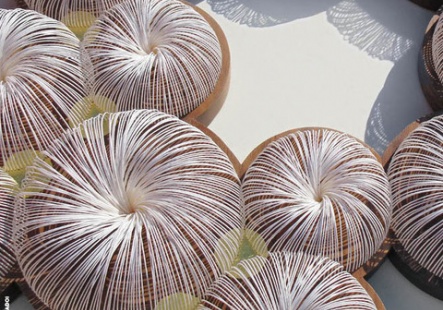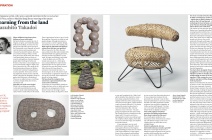Kazuhito Takadoi is on cover of September/October Crafts Magazine
14/09/2019
Kazuhito Takadoi is on cover of September/October Crafts Magazine
The Japanese artist, who won a special mention in the 2019 Loewe Craft Prize, talks to Malaika Byng about weaving with nature.
Learning from the land Kazuhito Takadoi
Interview by Malaika Byng
What childhood experiences have influenced your work today?
My family lived just outside the city of Nagoya, in Japan, surrounded by paddy fields and woodland, so nature was my playground. My father grew up deep in the countryside; every summer we would visit the forests and mountains and I became fascinated by plants. My aunt, an ex-teacher living in Tokyo, would bring me nature books when she visited. I was particularly drawn to those on western-style gardens, because Japanese people didn’t really grow herbs and flowers at that time. It encouraged me to go to horticultural college in Japan, and when I moved to the UK to study at the Royal Horticultural Society in Wisley, I would visit National Trust gardens as much as possible. Now nature is both my inspiration and my source material, which is provided in abundance from my garden and allotment in Birkenhead. There are no added colours: everything is natural, simply dried, then woven, stitched or tied.
How did your craft career begin?
While I was working as a gardener, I collected materials like leaves and mosses to make embroidered greeting cards, which is really where it all started. These experiments led me to go to Leeds Metropolitan University to study art and garden design. Although my intention was to pursue a career in garden design, I found that art soon took a leading role. What aspects of British and Japanese culture have fed into your practice? When I moved to the UK in the mid- 1990s, land artists like Andy Goldsworthy and David Nash were gaining attention, and they’ve had a big influence on my work. In Japan, everything is well made – from the plates you eat off to the tatami mats you sit on – which gives
you a natural affinity for craft. But the approach there is very rigid; you have to practise for years and years, because that’s the way it’s been done for centuries. If you bend the rules, it’s frowned upon. In the UK, there’s much more freedom to experiment and you can tear up the rule book. More emphasis is placed on being original.
Tell me about the sculpture that earned you a special mention in the 2019 Loewe Craft Prize.
A local farm is surrounded by hawthorn hedges that have to be cut back each year, and I have an arrangement with the farmer to harvest the twigs I require every January. These are kept for at least
a year until completely dry. I did a brief sketch initially, then started to create a basic shape using the hawthorn, tied together with linen twine using tweezers. Once the form was there, I spent another couple of months filling it in. I’m always inspired by circles, because they’re universal and planet-like. Also my character is sort of round – I’m easy- going and relaxed. But the space inside the rounded form is as important as the shape itself. It’s hard to see from a photograph, but when you walk around the sculpture [Kado (Angle), shown left], you can see how the twigs cast shadows across the interior.
It was amazing to see my work exhibited in Isamu Noguchi’s indoor stone garden Heaven at the Sogetsu Kaikan building in Tokyo [for the Loewe Craft Prize exhibition] as the organic forms of his sculptures and furniture have had a big impact on my practice, as you can see from this particular piece. It was an important moment for me personally too, because it was the first time my family had ever seen my work in the flesh. The V&A purchased a similar sculpture from my gallery, jaggedart, at Collect art fair last February – the first one I ever made with black linen twine – which will be on display in October.
Your work requires enormous precision, discipline and patience. How do get yourself in the zone?
It’s actually quite meditative, but listening to some classical music ensures I’m calm before I begin. If I’m not in a happy place, my work takes on an unhappy shape.
Nature is ephemeral. Are you interested in decay as much as growth?
My aim is to interrupt the process. If hawthorn twigs and grasses were just left outside, within months they would be gone. I step in to halt the decay.
You were recently invited to Sharjah by Irthi Contemporary Crafts Council – which aims to build a future for crafts in the UAE and beyond – to host workshops for local artisans, with artist Patricia Swannell and jaggedart. Tell us about your work there.
The women we met practise safeefah, the Emirati art of weaving with palm fronds, creating beautiful work but in a very traditional way. I was asked to teach them new embroidery techniques and ideas. They learnt how to make the palm strands very thin so they could embroider through washi paper, which they had never done before, and mix it with other materials like linen, bark and grasses. Patricia was there doing research for her tree drawings. We went for walks in the desert and along the beach, and I would find references for the artisans to give them direction, such as trees, landscapes and details like pebbles. We then collaborated with them to make a series of wall tapestries and I would add the finishing touches, like a moon in gold leaf. Their passion and enthusiasm were infectious. The results will be shown by Irthi at the London Design Fair this September.
You had a show alongside Swannell at jaggedart a few years ago and you will have another in October, this time collaborating on some of the works together. What synergy do you share with her and how will the dialogue work in practice?
Patricia is fascinated by the intricacies of nature, as am I. Her detailed portraits of trees are composed of minute handwriting in a pattern that echoes the rings of trunks, evoking the passing of time and making the ephemeral tangible. She also has experience in stitching, so it was ideal working with her in Sharjah, and that’s given us a lot of trust in each other’s creativity. Both of us approach our work in a serene yet almost obsessive way. We will create some of the works separately, but pick up on one another’s techniques. For example, I will use some of her tools for presentation, like the Latin names that recur in her work, while still using materials typical to my practice – twigs, washi paper, grass and gold leaf. Other pieces will be created together: Patricia will send me some of her prints and I will work on them, and vice versa. A dialogue will happen between London and Birkenhead, a process of experimentation, which makes us both scared and excited. ‘Alliance and Exchange’, a collaboration between Kazuhito Takadoi and Patricia Swannell, is at jaggedart, London,
10 October – 2 November. jaggedart.com


